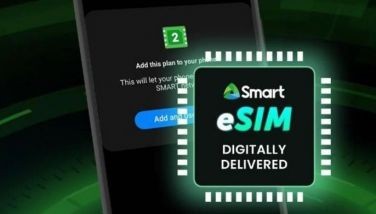PDA phones becoming the best mobile alternative to the PC
June 2, 2003 | 12:00am
In today’s fast-paced world, information is everything and the Internet is the best source for just about anything. Not only can you find everything on the Web, you can usually find it there first since it’s the next best thing to real-time information.
Now imagine the Internet at your fingertips. Mobile phones have become so sophisticated they can connect to the Internet and allow access to webpages although these are usually on WAP (Wireless Application Protocol), a standard used by wireless devices such as cellular phones to access data from the Web.
Nothing beats the whole HTML surfing experience unlike WAP versions that offer sparse and otherwise boring plain text webpages. Think using MS Word (or better yet, PowerPoint) versus WordPad.
Thus the birth of personal digital assistants (PDAs) which are turning out to be miniature versions of your ordinary personal computer (PC). PDAs give a "downsized" meaning to data management – both in memory size and the ability to run almost every application there is in the PC.
The emergence of hybrid PDA phones presents a logical two-in-one solution to this quandary. In short, transforming your stand-alone PDA into an instant mobile phone.
Now the problem with cellphone-PDA hybrids is that they have to be small enough to be mobile phones, and have a just large enough display as organizers or give the user a decent enough view of HTML pages when surfing the Internet.
GPRS (General Packet Radio Switch), a higher wireless standard than the current GSM, has turned Internet surfing into less of a drag by allowing for faster data transmission at about 14 kilobits per second (kbps).
A number of PDA phones have sprung up in the market recently, among them the Handspring Treo 180 and the much-anticipated Qtek 1010 (released in Europe as 02 XDA), which uses Microsoft’s Pocket PC 2002 Phone Edition.
These two PDA phone models are already available locally, either free or at a discounted price, through a G-Plan subscription from Globe Handyphone.
Net junkies whose idea of information on the fly is checking out NBA playoff results while riding the MRT (about two to three kilobits per page) or checking out one’s e-mail while waiting for dinner to be served (not to mention, a surefire way to impress your date), would definitely appreciate the Internet browsing service offered to G-Plan subscribers.
For only 25 centavos per minute starting last May 1, the Net surfing rate via the G-Plan has been cut by a whopping 50 percent from the previous 50 centavos.
Both the Treo 180 and Qtek 1010 are already GPRS-enabled and after the right network configuration, the user is ready to go into cyberspace and literally, surf the Internet on his fingertips.
Palm PDA users won’t have much difficulty using Handspring’s Treo 180. Running on a modified version of PalmOS 3.5 and powered by Dragonball 33Mhz processors, the PDA has features similar to any Palm-powered handheld.
The most conspicuous difference though is the presence of a Qwerty keyboard under the LCD screen – a plus for word-processor crazy users craving for something beyond your ordinary keypad or typing in words using graffiti.
The keyboard, however, complements the Treo 180’s much-touted quality – its wireless features. When you install the Palm Desktop, you can configure your Internet settings using a wizard that walks you through the process.
After setting up the service provider settings, the user is just a push of the button away from Internet heaven. One of the four default buttons runs Blazer, the Handspring’s Internet browser. With the One-Touch mail software included, the user can also access intranet e-mail via GPRS.
Although the keyboard buttons appear quite small, it takes getting used to and actually become comfortable after much twiddling. It makes for faster typing URLs, e-mail and SMS (unless, of course, the user is prone to typing shortcuts).
Blazer (the Treo’s Web browser) allows as much as 10 to 15 for preconfigured URLs so the user won’t need to retype them but direct the browser with one touch of the stylus.
The most striking thing about the Qtek 1010 is how it looks. The sleek, shiny-brushed metal alloy makes it a perfect James Bond gadget. New users will certainly find it a triumph in design compared to other plastic-coated PDA models.
But behind the outstanding form factor is what the device can actually do once the Start button is turned on. The latest Pocket PC OS virtually ported the entire Windows features into a PDA environment.
The flat-panel LCD display is also just right the size and is capable of delivering around 4,000 colors, just enough to display pictures, although at 14kbps, it could take a few minutes longer to download graphics-heavy webpages.
The Qtek’s GPRS compatibility, along with the version of Pocket Internet Explorer that comes with Pocket PC 2002, allows access to both WAP and websites. You can, for example, pick up Web mail or access your company’s intranet and cache important pages to read offline.
Pocket IE also supports SSL standard, so it’s even possible to perform secure transactions.
As with everything else in technology, there is no way to go but forward and it may only be a matter of time before PDA phones actually become the best mobile alternative to the PC.
Now imagine the Internet at your fingertips. Mobile phones have become so sophisticated they can connect to the Internet and allow access to webpages although these are usually on WAP (Wireless Application Protocol), a standard used by wireless devices such as cellular phones to access data from the Web.
Nothing beats the whole HTML surfing experience unlike WAP versions that offer sparse and otherwise boring plain text webpages. Think using MS Word (or better yet, PowerPoint) versus WordPad.
Thus the birth of personal digital assistants (PDAs) which are turning out to be miniature versions of your ordinary personal computer (PC). PDAs give a "downsized" meaning to data management – both in memory size and the ability to run almost every application there is in the PC.
Now the problem with cellphone-PDA hybrids is that they have to be small enough to be mobile phones, and have a just large enough display as organizers or give the user a decent enough view of HTML pages when surfing the Internet.
GPRS (General Packet Radio Switch), a higher wireless standard than the current GSM, has turned Internet surfing into less of a drag by allowing for faster data transmission at about 14 kilobits per second (kbps).
A number of PDA phones have sprung up in the market recently, among them the Handspring Treo 180 and the much-anticipated Qtek 1010 (released in Europe as 02 XDA), which uses Microsoft’s Pocket PC 2002 Phone Edition.
These two PDA phone models are already available locally, either free or at a discounted price, through a G-Plan subscription from Globe Handyphone.
Net junkies whose idea of information on the fly is checking out NBA playoff results while riding the MRT (about two to three kilobits per page) or checking out one’s e-mail while waiting for dinner to be served (not to mention, a surefire way to impress your date), would definitely appreciate the Internet browsing service offered to G-Plan subscribers.
For only 25 centavos per minute starting last May 1, the Net surfing rate via the G-Plan has been cut by a whopping 50 percent from the previous 50 centavos.
Both the Treo 180 and Qtek 1010 are already GPRS-enabled and after the right network configuration, the user is ready to go into cyberspace and literally, surf the Internet on his fingertips.
The most conspicuous difference though is the presence of a Qwerty keyboard under the LCD screen – a plus for word-processor crazy users craving for something beyond your ordinary keypad or typing in words using graffiti.
The keyboard, however, complements the Treo 180’s much-touted quality – its wireless features. When you install the Palm Desktop, you can configure your Internet settings using a wizard that walks you through the process.
After setting up the service provider settings, the user is just a push of the button away from Internet heaven. One of the four default buttons runs Blazer, the Handspring’s Internet browser. With the One-Touch mail software included, the user can also access intranet e-mail via GPRS.
Although the keyboard buttons appear quite small, it takes getting used to and actually become comfortable after much twiddling. It makes for faster typing URLs, e-mail and SMS (unless, of course, the user is prone to typing shortcuts).
Blazer (the Treo’s Web browser) allows as much as 10 to 15 for preconfigured URLs so the user won’t need to retype them but direct the browser with one touch of the stylus.
But behind the outstanding form factor is what the device can actually do once the Start button is turned on. The latest Pocket PC OS virtually ported the entire Windows features into a PDA environment.
The flat-panel LCD display is also just right the size and is capable of delivering around 4,000 colors, just enough to display pictures, although at 14kbps, it could take a few minutes longer to download graphics-heavy webpages.
The Qtek’s GPRS compatibility, along with the version of Pocket Internet Explorer that comes with Pocket PC 2002, allows access to both WAP and websites. You can, for example, pick up Web mail or access your company’s intranet and cache important pages to read offline.
Pocket IE also supports SSL standard, so it’s even possible to perform secure transactions.
As with everything else in technology, there is no way to go but forward and it may only be a matter of time before PDA phones actually become the best mobile alternative to the PC.
BrandSpace Articles
<
>
- Latest
Latest
Latest
February 22, 2024 - 3:17pm
February 22, 2024 - 3:17pm
December 28, 2023 - 12:00am
December 28, 2023 - 12:00am
December 11, 2023 - 11:00am
December 11, 2023 - 11:00am
November 23, 2023 - 4:35pm
November 23, 2023 - 4:35pm
October 16, 2023 - 5:00pm
October 16, 2023 - 5:00pm
Recommended































